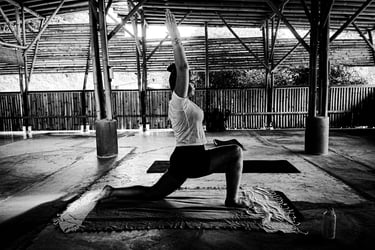Yoga and Walking
When walking is recommended, yoga can walk beside it.
Walking is often prescribed as a safe, accessible way to support circulation, joint health, and overall mobility. It encourages gentle movement without overwhelming the system—especially for those managing long-term conditions or recovering from injury.
Yoga, when approached mindfully, complements walking beautifully. Through breath-led movement, joint articulation, and nervous system awareness, it offers a different—but equally valuable—way to engage the body with care. It fills in the gaps, supporting balance, posture, coordination, and mental focus, without competing with what walking already provides.
When walking is the doctor’s advice, yoga doesn’t replace it. It walks beside it—as a sustainable, supportive practice that meets the body where it is.
There’s also something meaningful in how these two practices offer different relationships with movement. Walking often connects us with the external world and a sense of forward momentum. Yoga, meanwhile, invites internal awareness and present-moment attention. Together, they create a fuller movement vocabulary—one that is both outward-facing and deeply rooted within.
1. Arthritis & Joint Pain
Walking maintains circulation and eases movement without strain. Yoga gently mobilises stiff areas, improves flexibility, and may reduce inflammation through mindful, low-impact postures. Together, they offer a balanced way to stay active—without overloading sensitive joints.
2. Stress & Anxiety
Walking, especially in nature, carries a calming rhythm that quiets an overactive mind. Yoga deepens this effect with breathwork and slow, intentional movement that soothes the nervous system. While walking offers forward motion (a metaphor for progress), yoga roots us in presence. One step, one breath—they work hand in hand.
3. Balance & Ageing (Seniors)
Regular walking supports strength and coordination, essential for staying steady. Yoga adds focused balance work—through postures like Tree Pose or seated sequences—to strengthen stabilising muscles. Together, they build confidence in movement and reduce fall risk.
4. Post-Surgery & Rehabilitation
During recovery, walking is often the first step—literally—towards rebuilding endurance. Yoga supports this process by restoring range of motion, realigning posture, and preventing compensatory strain. It’s not about pushing limits, but listening to the body’s cues.
5. Weight Management & Metabolic Health
A short walk after meals can help regulate blood sugar. Yoga enhances this effect by lowering cortisol (a stress hormone that impacts weight) and improving insulin sensitivity. While walking burns calories, yoga fosters body awareness—making them a powerful duo for sustainable wellness.
6. Chronic Fatigue & Energy Regulation
Walking builds endurance gently, honouring fluctuating energy levels. Yoga offers restorative tools—like supported poses and breathwork—that replenish rather than deplete. Together, they support energy management with compassion and care.
7. Desk Work & Posture Imbalances
Walking counters the effects of prolonged sitting by reactivating underused muscles. Yoga addresses postural habits—like forward head position, rounded shoulders, and tight hips—creating a full-spectrum antidote to occupational strain.
8. Heart Health
Walking provides steady cardiovascular exercise that strengthens the heart without overexertion. Yoga supports heart health by reducing stress and blood pressure—deep breathing activates the parasympathetic nervous system, offering the heart space to rest. Together, they build stamina while protecting this vital organ.
9. Hypertension
Walking helps lower blood pressure by improving circulation and arterial flexibility. Yoga amplifies this through breath-led relaxation—studies show it can significantly reduce both systolic and diastolic readings. While walking gets the blood flowing, yoga teaches the vessels to relax.
10. Diabetes Management
Walking is well-established as medicine for diabetes—even a 10-minute post-meal walk can reduce blood glucose spikes. Yoga improves glucose metabolism through organ-stimulating postures and enhances insulin sensitivity. It also supports circulation and helps address neuropathy through gentle, targeted movement.
Whether you're walking for your heart, your joints, or your headspace—yoga is not a substitute, but a companion. Each supports the body in a different way. Together, they offer a more complete, compassionate, and sustainable approach to movement, recovery, and long-term wellbeing.
.


Further Reading
Stress Triangle : The First To Get Tense
A Back Strengthening Sequence : Spinal Strength
Our Daily Practice : Balancing The Doshas
More Insights
